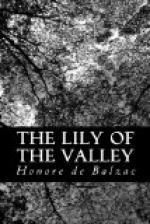I agreed, not without a blush of shame and pleasure. About four o’clock we reached the little chateau on which my eyes had fastened from the first. The building, which is finely effective in the landscape, is in reality very modest. It has five windows on the front; those at each end of the facade, looking south, project about twelve feet,—an architectural device which gives the idea of two towers and adds grace to the structure. The middle window serves as a door from which you descend through a double portico into a terraced garden which joins the narrow strip of grass-land that skirts the Indre along its whole course. Though this meadow is separated from the lower terrace, which is shaded by a double line of acacias and Japanese ailanthus, by the country road, it nevertheless appears from the house to be a part of the garden, for the road is sunken and hemmed in on one side by the terrace, on the other side by a Norman hedge. The terraces being very well managed put enough distance between the house and the river to avoid the inconvenience of too great proximity to water, without losing the charms of it. Below the house are the stables, coach-house, green-houses, and kitchen, the various openings to which form an arcade. The roof is charmingly rounded at the angles, and bears mansarde windows with carved mullions and leaden finials on their gables. This roof, no doubt much neglected during the Revolution, is stained by a sort of mildew produced by lichens and the reddish moss which grows on houses exposed to the sun. The glass door of the portico is surmounted by a little tower which holds the bell, and on which is carved the escutcheon of the Blamont-Chauvry family, to which Madame de Mortsauf belonged, as follows: Gules, a pale vair, flanked quarterly by two hands clasped or, and two lances in chevron sable. The motto, “Voyez tous, nul ne touche!” struck me greatly. The supporters, a griffin and dragon gules, enchained or, made a pretty effect in the carving. The Revolution has damaged the ducal crown and the crest, which was a palm-tree vert with fruit or. Senart, the secretary of the committee of public safety was bailiff of Sache before 1781, which explains this destruction.
These arrangements give an elegant air to the little castle, dainty as a flower, which seems to scarcely rest upon the earth. Seen from the valley the ground-floor appears to be the first story; but on the other side it is on a level with a broad gravelled path leading to a grass-plot, on which are several flower-beds. To right and left are vineyards, orchards, and a few acres of tilled land planted with chestnut-trees which surround the house, the ground falling rapidly to the Indre, where other groups of trees of variegated shades of green, chosen by Nature herself, are spread along the shore. I admired these groups, so charmingly disposed, as we mounted the hilly road which borders Clochegourde; I breathed an atmosphere of happiness. Has the moral nature, like the physical nature, its own electrical communications and its rapid changes of temperature? My heart was beating at the approach of events then unrevealed which were to change it forever, just as animals grow livelier when foreseeing fine weather.




